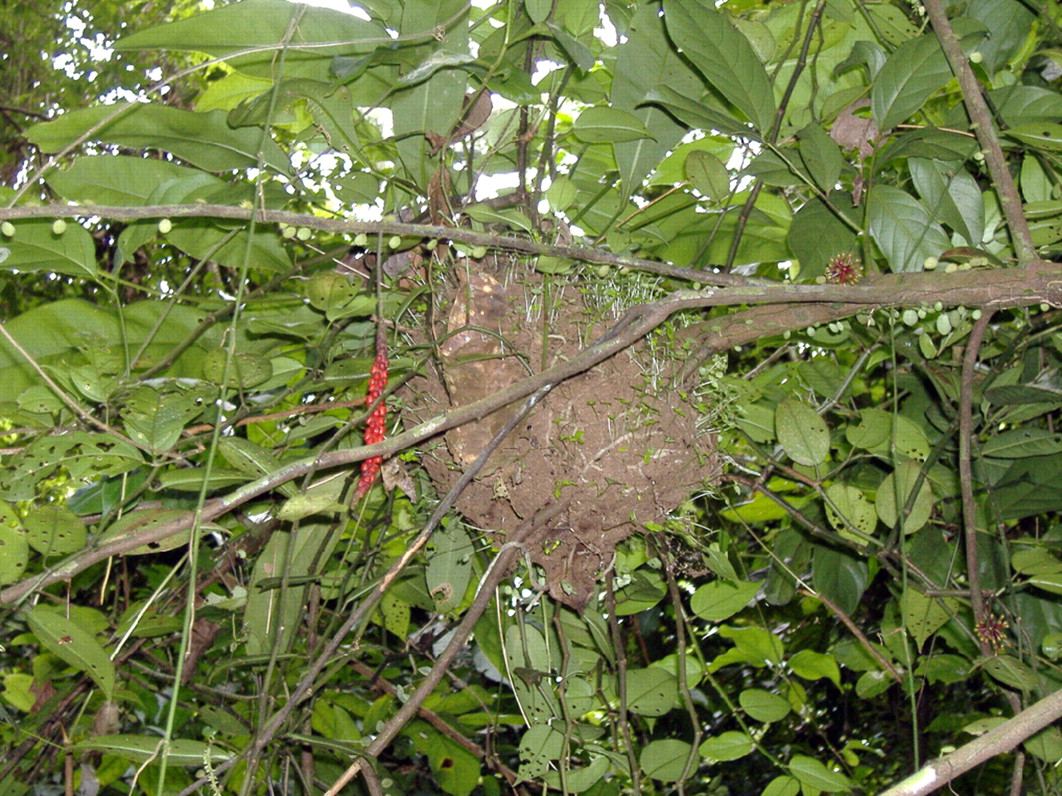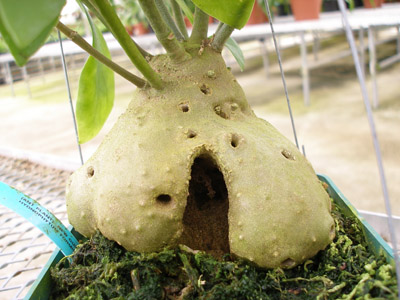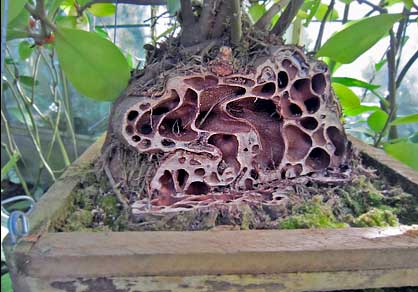The epiphyte seeds grow within the ant nest. These epiphyte species provide extra habitat their ant friends by threading roots throughout or providing hollow stems. In return, the ants defend their new castle from herbivores and the waste and detritus produced by the colony feeds the epiphytes and protects them from severe drought.
|
In some parts of the world, ant garden epiphytes are very common. Arboreal ants build shelters out of vegetable fibers, refuse, feces and secretions in which to house their nests. During or after this building, the seeds of "ant-garden" epiphyte species (such as Hydnophytum) are brought into the nests where they happily germinate. The seeds of some epiphyte species produce a chemical which is similar to ant pheromones and may act as an attractant. The epiphyte seeds grow within the ant nest. These epiphyte species provide extra habitat their ant friends by threading roots throughout or providing hollow stems. In return, the ants defend their new castle from herbivores and the waste and detritus produced by the colony feeds the epiphytes and protects them from severe drought. In some cases it, the records I've read suggest the plant grows and THEN the ants inhabit it. Which ever way it works, it seems like a pretty awesome relationship!
4 Comments
Angela
10/4/2014 06:00:25 pm
Very interesting! I wonder what signalling goes on between the ants and plant to induce this castle formation... and how does it affect the rest of the host plant functioning
Reply
Catherine
13/4/2014 06:59:03 am
There has been oodles of research done on this, try searching google scholar for a few snapshots! It sure is a fascinating area of canopy science. Thanks for your comment.
Reply
Derrick
11/11/2014 09:10:13 am
Correctly it is Hydnophytum formicarum.
Reply
Derrick
2/2/2015 07:24:17 am
@ Angela. The chamber tunnel systems in the tubers of Rubiaceae sub tribe hydnophytinae all form naturally, thus needing zero inputs from resident ants. However, certain mutualistic ant species for example Philidris cordata in Australia and New Guinea, deliberately place their various waste products in specialised so-called 'warted tunnels' where home plants access the nutrients from its decomposition. How this practice has evolved is unknown but perhaps the plants have somehow trained their preferred ant guests. It has been hypothesized that the 'warts' might periodically exude moisture making such tunnels unsuitable for nesting. The ants certainly prefer smooth walled chambers for their broods.
Reply
Your comment will be posted after it is approved.
Leave a Reply. |
Subscribe to NZ Epiphyte Blog:Like us on Facebook!
Catherine KirbyI work with NZ's native vascular epiphytes at the University of Waikato. I completed an MSc on epiphyte ecology and the shrub epiphyte Griselinia lucida and have recently published the Field Guide to NZ's Epiphytes, Vines & Mistletoes. Categories
All
Archives
August 2016
|




 RSS Feed
RSS Feed
